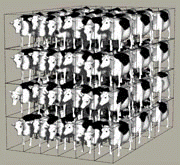Animal Science, Department of

World Congress on Genetics Applied to Livestock Production: 3rd (1986)
Date of this Version
1986
Abstract
In his introduction to the Plenary Session of the First World Congress on Genetics Applied to Livestock Production for Sheep, Rae (1974) pointed to the wide diversity of sheep production systems throughout the world. Goats add further to this range in production environments, husbandry systems and to the variety of products for which these two domestic species are farmed. Such variety makes any consolidated review of Genetic Improvement Programs for sheep and Goats very difficult, especially if all important operational features of ~e production and marketing circumstances for each end product are to be considered in evaluating the success of programs currently being applied around the world. For this reason a decision was made in planning this Session not to attempt the difficult task of reviewing in-depth all those applications of genetic improvement for which published information is available. Rather, it was decided to attempt to draw out the different ways in which breeding programs may be evaluated, giving emphasis to the sort of approaches that have been taken. Because this format would need to refer to specific examples it was considered that these could be chosen to illustrate particular operational features and genetic principles upon which different programs are based. It was also considered that this format would prevent some repetition of descriptive detail already published and that it would provide greater operational insight by highlighting actual applications appropriate to different species, breeds and traits as well as to the production circumstances under which animals were managed. Throughout this review, genetic improvement is confined to the application of selection, there being a separate Plenary Session of the Congress devoted to Evaluation and Utilisation of Breed Resources through crossbreeding. Other mating plans are also ignored, such as from an inbreeding point of view (Rae 1981), but not from the point of view of applying selection in sire-breeding flocks and especially in the nucleus flocks using elite matings for sire production. These aspects are an important feature of the second review paper by NICOLL et al., which considers inter-flock relationships for application of genetic improvement in a population as a whole rather than only in terms of genetic progress for an individual flock. The latter details are the subject of the first review paper by ATKINS et al..


Comments
Published in 3rd World Congress on Genetics Applied to Livestock Production, edited by Gordon E. Dickerson and Rodger K. Johnson, 4 vols. (Lincoln: University of Nebraska Institute of Agriculture and Natural Resources, 1986). Copyright © 1986 Board of Regents University of Nebraska.